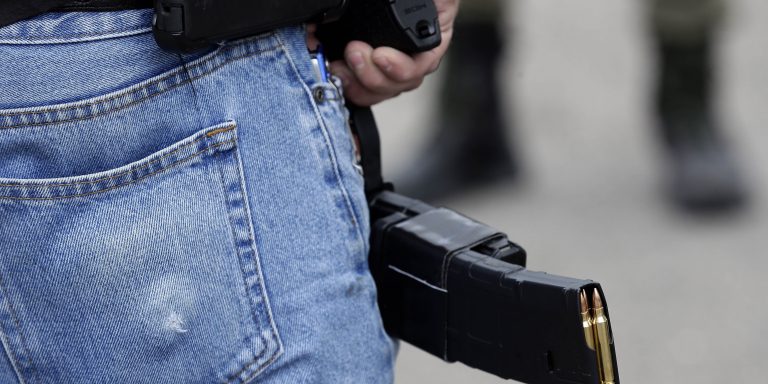INTELBRIEF
August 11, 2020
IntelBrief: The United States Remains a Tinderbox as Tensions Continue to Mount

Bottom Line Up Front
- As the United States approaches the November 2020 Presidential election, the nation continues to struggle with numerous issues, including deepening economic concerns, a public health crisis, and mounting racial tensions.
- Set against the backdrop of protests and demonstrations throughout the country is the menace of heavily armed civilians and the possibility of miscommunication or antagonisms that lead to violence on U.S. soil.
- It is difficult to overstate the potential threat posed by angry and heavily armed protesters who appear at many demonstrations across the country.
- It is increasingly difficult to discern the difference between law enforcement and armed vigilantes, as large groups of individuals now attend rallies, protests, and demonstrations dressed in tactical gear armed with rifles.
Across the United States, armed citizens are taking it upon themselves to attend demonstrations and protests, often times, in an effort to intimidate protesters or engage in a public show of force, as occurred at several state capitols in recent months. The presence of vigilantes is likely to spark a broader conflagration at some point, resulting in death and injury to civilians and an inevitable confrontation with police and law enforcement. In New Mexico, where a shooting took place at protests, armed militias showed up at demonstrations and attempted to provide security, usurping the job of local law enforcement. In Seattle, WA and Portland, OR, federal law enforcement officers have clashed with protesters for weeks. Civil unrest and violence have assumed a partisan frame, with armed civilians across the political spectrum representing and vowing to protect their respective ‘tribe,’ including both left-wing and right-wing agitators. Each side characterizes the other, inaccurately, as a monolith, and suggests they operate in bad faith. Armed groups speak in messianic tones, self-righteous in the purity of their beliefs, which American newspapers usually do not hesitate to label as terrorists, extremists, or militants when it occurs overseas. Debates surrounding the closure of businesses during the COVID-19 pandemic and nationwide protests surrounding the murder of George Floyd have further exacerbated already simmering tensions.
At nearly every public demonstration—from objections over public health measures like wearing masks to protesting police misconduct—civilians dressed in tactical gear with sophisticated weapons have appeared. From a law enforcement and public safety point of view, these protests are an accident waiting to happen. Most states have their respective versions of ‘Open Carry’, in which there is no permit or special qualifications to carry rifles and pistols in public as long as they are openly visible. Local police departments have been criticized for becoming too military-esque in their equipment, clothing, and tactics. But the spread of military-style equipment and uniforms extends beyond the police and now reflects large segments of civilian protesters, especially those who hold anti-government and anti-law enforcement views.
Identifying credible threats is a major component of the daily work of local law enforcement throughout the country. Large numbers of heavily-armed, angry, and aggressive citizens protesting and counter-protesting presents myriad challenges for those tasked with quelling unrest. To date, one of the most effective tactics has been to try to keep all sides physically separated, but this is a significant challenge amidst the chaos of large-scale demonstrations. There have also been allegations of agent provocateurs attempting to instigate mayhem. Extreme fringes of both the left-wing and right-wing have contributed to instability, and politicians often play the blame game by pointing the finger at the opposing side. Some more recent phenomena like the ‘Boogaloo’ movement are deliberate about the desire to escalate tensions to disrupt society, while left-wing extremists, particularly Anarchists, have also sought to wreak havoc. There is no workable public safety strategy when there are so many guns and so much confusion that inevitably arises during these street protests, especially when particular elements may be specifically targeting civilians or law enforcement, including so-called accelerationists.
As a country, the United States is still confronting a pandemic that the government has been unable to tame, and most experts believe that the country remains mired in the nascent stages of economic distress stemming from unemployment and lost wages resulting from the coronavirus. Politically, the rhetoric related to the November elections is increasingly apocalyptic. Protests—both violent and nonviolent—continue across the country and are related to a tapestry of local and national issues. All the while, heavily armed citizens are preparing for a public fight with their perceived enemies. Entirely too much now hinges on the trigger fingers of angry Americans. There is nothing innocuous or benign about this looming threat. With the presidential political campaign entering full-swing as the calendar inches closer to November, the country feels like a tinderbox, with armed civilians, rampant disinformation, a health crisis, and accusations of vote rigging forming a combustible combination.